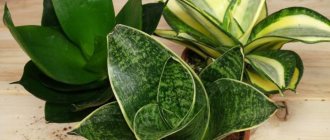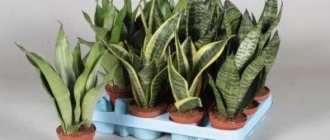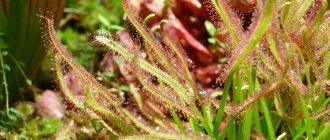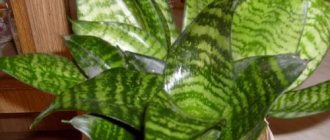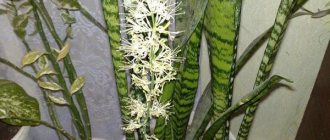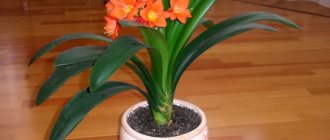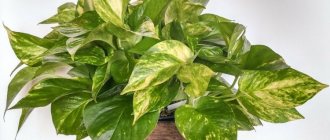This member of the agave family is widely known and is a common houseplant. There are about 60 species of evergreen plants in the genus, inhabitants of the semi-deserts of Kenya, Madagascar, Namibia, and Angola.
Sansevierias are perennial rhizomatous plants with greatly shortened stems and succulent leathery flat (sometimes cylindrical) leaves up to several meters long, collected in rosettes. The epidermis often has a decorative pattern of variously colored spots, streaks and stripes. In spring, flower stalks grow from the center of the rosettes, bearing spikelets with rather inconspicuous small flowers of white or greenish-cream color.
Plants grow well in a wide range of temperatures, light and humidity. The optimal temperature ranges from 12-25 degrees. Plants need moderate watering throughout the year and very moderate watering in winter (once a month or less). Always let the soil dry out before watering. Air humidity is not particularly important for sansevieria.
They reproduce vegetatively - by lateral shoots and leaf cuttings, variegated forms - only by dividing the rhizome. The best time for propagation and transplantation is spring.
Frequent replanting is not required; replant as needed, preferably in a shallow container with good drainage. Soil substrate: turf and leaf soil, humus, peat and sand in equal proportions. You can use a substrate for geraniums with the addition of coarse sand (it should be at least 30%).
Sansevierias are one of the most unpretentious indoor plants. they will feel comfortable in a group composition in a flower bowl or in a miniature green corner formed from several sectional containers of different sizes and shapes.
Sansevieria blooms only in sunlight.
The plant is very hardy: it grows in both sun and shade, tolerates dry air and drafts, rare watering and rare replanting. The only condition is that the plant cannot be overwatered: Sansevieria does not like waterlogged soil.
Sansevieria cylindrical is a perennial rhizomatous rosette plant with succulent, hard, round-cylindrical, dark green leaves pointed at the end, up to 40-70 cm long, 8-10 in an elongated rosette, often with a groove and whitish stripes. Peduncle up to 30cm tall. The flowers are snow-white, often slightly pinkish. Blooms in June–July.
What does Sansevieria cylindrical look like, what family does it belong to?
Sansevieria cylinder or cylindrical (Sansevieria Cylindrica) is popularly called simply - Pike tail. The plant of the Asparagus family is characterized by long, tube-shaped leaves that grow directly from the ground. They are very smooth to the touch and shiny due to the fact that they are covered with a dense wax layer.
The cylindrical species of Sansevieria has leaves wrapped in a tube.
Common varieties
The most famous and popular varieties of this type of plant are:
- Sansevieria Velvet Touch - got its name because of the velvety-to-the-touch stems.
- Sansevieria Bacularis is a bush with dense dark green tubular leaf blades that do not close on the stem, but grow from the ground.
- Sansevieria Skyline - has smooth and shiny leaves with dark stripes.
- Sansevieria Twist - can grow up to 50-60 centimeters, according to the external description it is very similar to the cylindrical appearance.
- Sansevieria Spaghetti - leaves are rounded, with small grooves along their entire length.
- Sansevieria Mikado is a very rare variety with thick, fleshy leaves and dark green vertical lines on them.
Medicinal properties
The great advantage of Sansevieria is that it has medicinal properties:
- normalizes blood pressure;
- improves the overall well-being of the body and strengthens the immune system;
- treats colds;
- used externally to treat inflammation and other skin diseases;
- normalizes the functioning of the gastrointestinal tract.
Briefly about the history of appearance
The plant is native to South Africa. At the beginning of the 20th century, Sansevieria was exported to Europe, from where it migrated as an indoor flower to the rest of the world.
Features of plant care at home
It is easy to care for cylindrical sansevieria; the main thing is to create certain climatic conditions in the room where it grows.
Temperature
Sansevieria - home care and reproduction
The most comfortable temperature for a flower is +10... +25 degrees. The bush normally tolerates a sharp cold snap, but in hot weather it is better to place the pot in ventilated areas.
Lighting
The flower has no special requirements for lighting. It is better to keep it in diffused light so that the sun's rays cannot burn the fleshy decorative leaves of the sansevieria.
Watering
During the growing season, the bush needs to be watered once every 7-10 days, but during the dormant period it is enough to lightly moisten the soil once a month.
Important! During wintering, it is better not to water the soil, but to spray it with a spray bottle, but avoid getting water on the ground part of the flower.
Spraying
Caring for sansevieria does not require a spraying procedure. This can cause leaves to rot due to water getting into the axils. It is better to wipe the plates with a damp cloth.
Humidity
It is advisable to keep humidity levels at an average level. If necessary, you can increase it by adding water to the pot tray.
Priming
The flower prefers slightly acidic soil. The substrate can be prepared at home. To do this, you need to mix loose soil, sand and a small amount of humus.
It is better to purchase a substrate for a flower in a store.
Feeding
To fertilize the plant, you need to choose special complex mineral fertilizers intended for succulents. The soil needs to be constantly replenished with potassium and phosphorus.
Note! When feeding a plant with fertilizers containing a large amount of nitrogen, its leaves lose their variegated color and become monochromatic.
Landing rules
Cylindrical Sansevieria will grow well even in the depths of the room, so there is no need to select its place of “residence” based on the cardinal directions and room illumination. However, if the variety has brightly colored leaves, or if the owner wants to achieve flowering, it is better to place the pots in places with good access to light. It is better to place the plant not on the floor, but at least on small stands. You can place a decorative bush on a table or chest of drawers. The culture feels good at any living temperature. To make it bloom, you can try to temporarily remove it into a colder space, but the result of such a procedure is not one hundred percent.
It is allowed to replant the plant at the moment when it is actively developing, and it is better to do this in the spring. Young plants should be stirred every year and a half, and adults - once every couple of years. The soil should be light and loose, not containing peat, and having a slightly acidic or neutral reaction. The optimal soil can be formed from turf, leaf soil, and sand. Some experts also add a little humus . Even such modern materials as hydroponics, inert soil or rocky decorative soil are suitable.
When and how does it bloom
Sansevieria Hanni - home care
The flowering of Sansevieria cylindrical goes almost unnoticed. The inflorescences are brush-shaped and are located on a long and erect peduncle. It is the same in length as the leaves of the flower, but sometimes it is longer. Small flowers with white-cream petals are tubular in shape. Some varieties have pale pink flowers.
The bush blooms for only about a week. Already 5-8 days after the buds open, they begin to close back and fall off.
Blooming sansevieria
Photo
In the photo below you can see what Sansevieria cylindrica looks like and what leaves it has:
And this is a photo of how the cylinder blooms:
Nowadays, when every minute counts, but you still want something homey, cozy and beautiful, Sansevieria can settle on your windowsill. There is probably no more unpretentious plant that will not require a lot of attention and time from you to care for itself. Before choosing a variety, you should carefully familiarize yourself with such types of this beauty as Velvet Touch, Hanny, Laurenti, Moonshine and Three-Stripe.
How does Sansevieria cylindrica reproduce?
This species can reproduce in several ways, all of which are easy to use.
Germination of seeds
Mother-in-law's tongue flower - home care
Reproduction of Sansevieria cylindrical by sowing seeds is practically not used in home floriculture. Sow seeds in boxes with substrate for succulents. They need to be deepened by 1-2 centimeters. Then pour and cover with film. In a month the first shoots will appear.
Rooting cuttings
To propagate the plant by cuttings, you need to cut a part from the side leaf about 10 centimeters long. The cuttings are buried in a box with soil mixture, watered and covered with film.
Important! To prevent the plant from getting sick, the cut areas are treated with activated charcoal or charcoal.
Propagation by cuttings
Air layering
It is possible to propagate a flower using secondary rosettes; this method is similar to rooting lateral layers. In the spring, the rosettes are separated from the bush and planted in a separate pot.
Reproduction methods
You can get a new sansevieria using different methods. Seeds of a plant or parts of it - for example, cuttings - are suitable for this. You can also divide an adult, overgrown bush into several smaller ones. For propagation by leaf cuttings, large leaves are cut off at the root and divided into pieces 5-10 cm in size. They should be rooted in a light substrate, buried by about 2 cm and after drying the cut.
Possible problems in cultivation and diseases
Sansevieria practically does not suffer from pests and diseases, but occasionally problems still arise.
The flower sheds buds and leaves
Most often this occurs due to dry indoor air. Sometimes a flower simply lacks some minerals in the soil.
The leaves are turning pale
This condition occurs due to a lack of fertilizing and lighting. It is better to keep the bush in slightly diffused light, but not in the shade.
The tips of the leaves are drying out
The edges of the leaves dry out due to dry air and high indoor temperatures. Sansevieria does not like heat, so you should take care of a suitable growing room in advance.
The lower leaves fall off
This happens due to excessive watering and poor quality water. Liquid that is too cold can quickly destroy the bush.
Pests
Among the pests, a flower can be affected by a spider mite, which weaves a barely noticeable web on the leaves. Insects love to feast on fleshy leaves, causing them to dry out and die.
Signs and superstitions
Since ancient times, Sansevierias have been credited with various magical properties due to the fact that they have many medicinal properties. It is believed that the plant brings peace and prosperity to the house, protects household members from quarrels and troubles.
However, there is one well-known superstition associated with Sansevieria. Because of its sharp leaves, it is nicknamed Mother-in-Law's Tongue and it is believed that the plant promotes gossip and sows misunderstanding among the inhabitants of the house.
The plant has an elegant appearance
Sansevieria cylindrica is distinguished by its decorative leaves, which, although not variegated, have a sophisticated and elegant appearance. Easy care only contributes to the popularity of this variety in home gardening.
ethnoscience
Despite the content of toxic substances, sansevieria also has beneficial properties. It contains a lot of saponins - a foaming substance used to make soap toiletries.
The healing qualities of the flower are used in the pharmaceutical industry for the production of tonic, choleretic, anti-inflammatory and other medicines.
Sansevieria is well known among traditional healers. It is taken for cystitis, inflammation of the throat and mouth, and has proven itself as an immune-strengthening substance.
The disinfecting effect of the flower leads to accelerated healing of wounds by treating them with the juice of the culture. But keep in mind that the flower contains poisonous components, so do not attribute drugs based on it yourself.
According to popular rumor, sansevieria in the house will help avoid quarrels, misunderstandings and other family troubles. Its pointed leaves take away all the negativity in the house. Psychics believe that when a flower throws out its flowers, proceed to the upcoming planned activities, and they will definitely be successful.
But the winter flowering of sansevieria foreshadows breakups and quarrels with loved ones.
